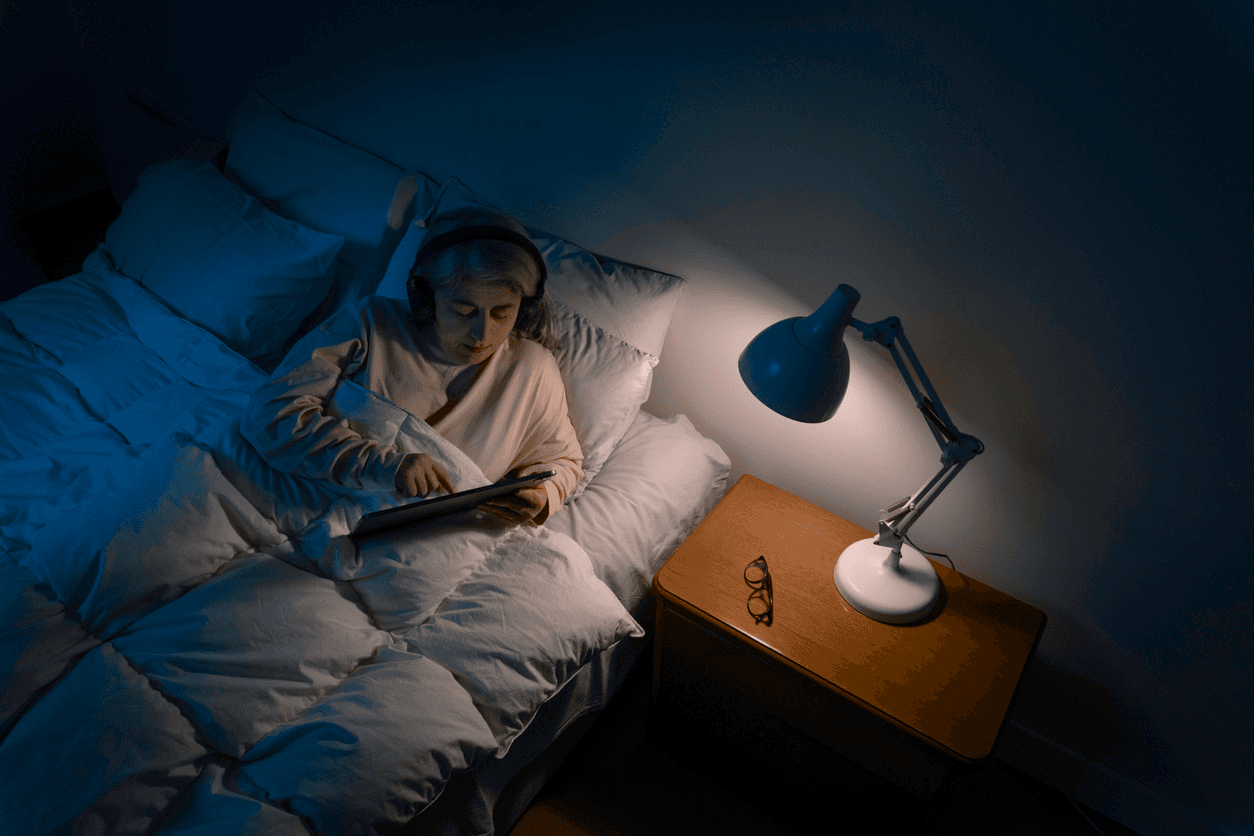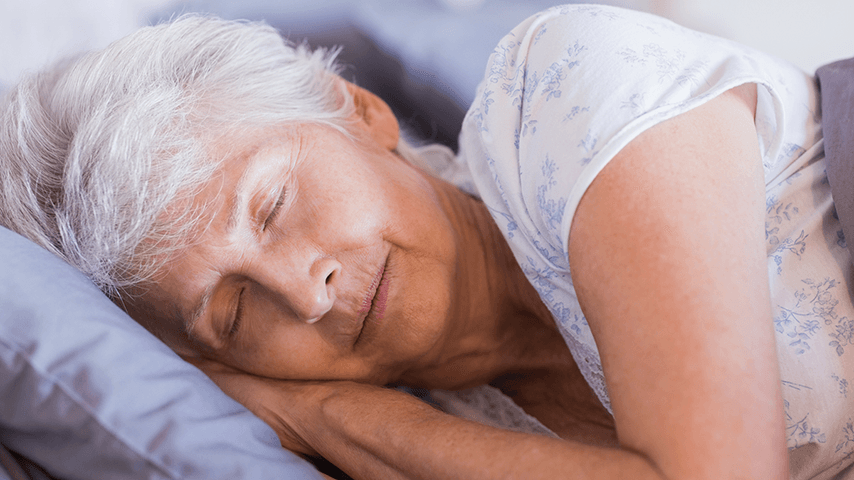
Related Topics
Sleeping well is is crucial for good physical and mental health and longevity. And getting the recommended 7-9 hours of it each night1 is especially important as we age.
But achieving good quality sleep can easier be said than done. That’s because the older we get, the more things can get in the way: like chronic pain.
Understanding the relationship between sleep and chronic pain
What is chronic pain?
Defined as lasting for three months or more, chronic pain (such as sciatica) affects as many as 50 million adults in the United States.2 And the impacts on daily life can be significant. For instance, among surveyed women age 65 and over who live with mild to moderate disability, most pointed to musculoskeletal pain as the cause.3 These women also report decreased mobility, increased difficulty performing the activities of daily living, and fatigue.
Chronic pain affects mental health, too. When we’re in pain, we’re more likely to experience problems such as depression and anxiety. Further, limited mobility and ongoing discomfort can lead to social isolation—which makes depression and anxiety worse.
What common conditions are linked to chronic pain?
Chronic pain can be age-related; it also can be caused by one of many health conditions, including:
Arthritis
Simply put, “arthritis” means “joint inflammation.” While there are more than 100 different types, osteoarthritis (OA) is the most common. When our hips, knees, hands, or feet are stiff or sore, OA is often to blame. Inflammation damages the bones, cartilage, tendons, and even muscles around the bones, which makes things hurt.
It’s true that our risk for osteoarthritis increases with age, but there are many effective strategies for slowing its progression and easing its pain. If you have arthritis and it’s worse in the morning—a fairly typical phenomenon—you might consider a mattress for arthritis.
Back pain
Most of us have experienced some form of back pain in our lives: we’ve been in an accident, picked up something too heavy and strained a muscle—or we’ve slouched in front of the computer for too long and messed up our posture. These issues rarely persist and generally get better with time and simple interventions.
But certain issues—like a herniated disc, spinal fracture, or degenerative condition—can lead to persistent back pain. Millions of Americans suffer from this kind of pain, and it’s one of the most common reasons people go to the doctor or miss work.4,5
Migraines
A migraine is not “just” a headache. It’s a debilitating attack often described as throbbing, pulsing pain accompanied by nausea, numbness to the face, and visual disturbances, among other symptoms.
Episodic migraines, which are infrequent, affect as many as 15% of the global population. Chronic migraines—which occur as many as eight times per month for three or more months—affect about 2% of the global population.6 Regardless of the type, migraine-associated pain very often disrupts work, family, and social activities.
Fibromyalgia
This condition causes general, near-constant dull aching and crushing fatigue that doesn’t improve with sleep. And for people who have it, fibromyalgia can cause their brains to misinterpret nonpainful signals as pain.7
Fibromyalgia can be frustrating to live with because it’s invisible and not well understood. Still, as many as 1 in 25 people in the United States has it.8 As with osteoarthritis, pain can be worse at night and in the morning, which means a good mattress for fibromyalgia can help make a difference.
Cancer
Cancer doesn’t always cause pain. When it does, it usually stems from a tumor (especially if it’s pressing on a nerve or other sensitive part of the body); surgery; metastases (spread) to the bones; or the side effects of radiation, chemotherapy, or other treatments.9
While cancer risk does rise with age, current data suggest a shrinking trend among adults age 65 and over. Between 1999 and 2020, the prevalence of cancer in this age group dropped from 61% to 58%, according to the American Cancer Society.10
In people who do have cancer, their pain can be acute (sudden and short-lived); breakthrough (when pain medications don’t control it well); or chronic.
Neuropathy
Also called “peripheral neuropathy,” this nerve-related pain isn’t a standalone disorder. Rather, it’s caused by or associated with a variety of other conditions such as diabetes, autoimmune diseases, traumatic injuries, toxic exposures, certain infections, and even low levels of Vitamin B.
Neuropathy generally causes stabbing pain in the hands and feet, but also it can affect other parts of the body and cause symptoms such as tingling, burning, numbness, weakness, and more.
What is the impact of pain on sleep?
Among those 50 million Americans with chronic pain, between 67-88% of them suffer from sleep disturbances.11 These can include:12
- Trouble falling or staying asleep
- Waking up sooner than desired
- Not feeling well rested in the morning
Each of these disturbances is characteristic of insomnia: a condition that can be a temporary nuisance—or develop into a long-term pattern that affects quality of life. Chronic sleep deprivation impacts our ability to focus on important tasks; dampens our mood; and even increases our risk of falls. It’s also been linked to stroke, obesity, depression, and heart and kidney disease.13
What is the impact of poor sleep on chronic pain?
Chronic pain and sleep disturbances are tightly bound in a cycle that can be hard to break. When we’re in pain, we don’t sleep well; and when we don’t sleep well, our pain often gets worse.
In fact, research shows that when we don’t get enough good-quality sleep, we are more likely to develop:14
- Chronic pain
- Heightened pain sensitivity
- Spontaneous unexplained pain
And this is how the cycle perpetuates. These types of pain can make it more difficult to fall and stay asleep; and, over time, disturbed sleep makes us more susceptible and sensitive to pain.
What psychological factors impact pain and sleep?
Perhaps unsurprisingly, our mental health can suffer in the presence of chronic pain and poor-quality sleep. Pain can make us anxious; anxiety can leave us awake at night; and sleep disruptions can lead to depression.
For many people, this all can add up to a sense of isolation and loss. When pain robs us of simple pleasures, like picking up a grandchild, hugging a friend, or standing in the kitchen to make a holiday meal, it can become more challenging to maintain a positive outlook.
Tips for improving sleep with chronic pain
But there is good news. Chronic pain and poor sleep are bi-directional: as we’ve seen, one impacts the other. And this relationship can be positive as well as negative. When we get better sleep, we can reduce the effects of pain.
Strategies to help you practice good "sleep hygiene":
- Keep a regular sleep schedule. Going to bed and getting up at the same time each day reinforces your body’s natural sleep cycles.
- Reserve your bedroom for sleep. This trains your brain to associate one with the other. Keep the temperature comfortable and resist the urge to eat, work, or watch TV here.
- Avoid eating and drinking too close to bedtime. A full stomach can make it hard to fall asleep. Caffeine and alcohol can disrupt it. So can the need to urinate in the middle of the night, which caffeine and alcohol can cause.
- Cut down on screen time. “Blue light” from digital devices disrupts circadian rhythms, especially within an hour of turning in. And media consumption can be upsetting.
- Develop a night-time ritual. Help your body and mind to wind down by engaging in a quiet, soothing activity: taking a bath; writing in a journal; listening to some relaxing music.
- Address sleep-related anxiety. If you awake in the middle of the night and can’t fall back asleep, don’t worry. Get up and try reading or another calm activity until you feel sleepy.
If you try these techniques and don’t notice improvement within a few weeks, it might be time to consult your health care team about other options for treating your insomnia. Depending on your particular situation, health history, and any medications, these may include:
- Cognitive behavioral therapy (CBT). Doctors often recommend CBT as the first treatment option for long-term insomnia. Cognitive behavioral therapy for insomnia (CBT-I) is a specific approach lasting six to eight weeks. It’s an effective treatment to help you fall asleep faster and stay asleep longer. CBT-I may include other sleep strategies, including meditation and developing good sleep hygiene.15
- Melatonin supplements. Melatonin is a hormone that’s connected to circadian rhythm. Your brain produces melatonin in response to darkness to prepare you for sleep. Melatonin supplements can help with certain sleep disorders, though not enough is currently known about it to definitively conclude it’s effective with insomnia.16
- Increasing physical activity. Regular, moderate exercise (like a stroll around the block) can help not only with managing chronic pain but also with improving sleep.17 Talk to your doctor about the types of activity that might be helpful for you.
- Sleeping pills. This broad category includes both over-the-counter (OTC) medications containing antihistamines and prescription drugs called hypnotics. OTC pills for sleep are widely available, but you should use them with extreme caution or avoid them altogether; that’s because certain ingredients can negatively interact with other medications or cause unwanted side effects on their own. Always consult with your health care provider before trying any kind of sleeping pill, even the ones available without a prescription.
The bottom line
Chronic pain and sleep disturbances often go hand-in-hand. Pain affects our sleep quality; and when we don’t sleep well, our ability to tolerate pain declines. Together, these things can lead to anxiety and depression, which sets the stage for a cycle that’s hard to break.
But it can be broken. Improving sleep, even with chronic pain, is possible. In addition to working with your health care team to address the causes and symptoms of your pain, you can try some simple at-home strategies that can help with managing pain and sleep.
Finding the best mattress for you can help improve your sleep quality, too.
Sources
1. Hirshkowitz, et al. National Sleep Foundation's updated sleep duration recommendations: final report. Sleep Health. December 2015. Found on the internet at https://www.sleephealthjournal.org/article/S2352-7218(15)00160-6/fulltext and https://pubmed.ncbi.nlm.nih.gov/29073412/
2. S. Michaela Rikard, PhD, et al. Chronic Pain Among Adults – United States, 2019-2021. CDC Morbidity and Mortality Weekly Report. April 14, 2023. Found on the internet at https://www.cdc.gov/mmwr/volumes/72/wr/mm7215a1.htm#contribAff
3. Suzanne G. Leveille, PhD, et al. The pathway from musculoskeletal pain to mobility difficulty in older adult women. Pain. March 2007. Found on the internet at https://www.sciencedirect.com/science/article/abs/pii/S0304395906004568
4. WebMD. Causes of Back Pain. March 13, 2024. Found on the internet at https://www.webmd.com/back-pain/causes-back-pain
5. Mayo Clinic. Back Pain. Found on the internet at https://www.mayoclinic.org/diseases-conditions/back-pain/symptoms-causes/syc-20369906
6. Cleveland Clinic. Chronic Migraine. Found on the internet at https://my.clevelandclinic.org/health/diseases/9638-chronic-migraine
7. Mayo Clinic. Fibromyalgia. Found on the internet at https://www.mayoclinic.org/diseases-conditions/fibromyalgia/symptoms-causes/syc-20354780
8. Johns Hopkins Medicine. Fibromyalgia. Found on the internet at https://www.hopkinsmedicine.org/health/conditions-and-diseases/fibromyalgia
9. American Cancer Society. Pain in People With Cancer. Found on the internet at https://www.cancer.org/cancer/managing-cancer/side-effects/pain/cancer-pain/pain-in-people-with-cancer.html
10. Sonya Collins. 2024—First Year the US Expects More than 2M New Cases of Cancer. The American Cancer Society. January 17, 2024. Found on the internet at https://www.cancer.org/research/acs-research-news/facts-and-figures-2024.html
11. Patrick H. Finan, PhD, et al. The Association of Sleep and Pain: An Update and a Path Forward. The Journal of Pain. December 2023. Found on the internet at https://www.jpain.org/article/S1526-5900(13)01199-1/fulltext
12. William Deardoff, PhD. Chronic Pain and Insomnia: Breaking the Cycle. Spine Health. December 12, 2016. Found on the internet at https://www.spine-health.com/wellness/sleep/chronic-pain-and-insomnia-breaking-cycle
13. National Heart, Lung, and Blood Institute. What Are Sleep Deprivation and Deficiency? March 24, 2022. Found on the internet at https://www.nhlbi.nih.gov/health/sleep-deprivation
14. Monika Haack, et al. Sleep deficiency and chronic pain: potential underlying mechanisms and clinical implications. Neuropsychopharmacology. June 17, 2019. Found on the internet at https://www.ncbi.nlm.nih.gov/pmc/articles/PMC6879497/#:~:text=Chronic%20pain%20is%20highly%20comorbid%20with%20sleep%20that,turn%20lowers%20pain%20thresholds%20and%20increases%20spontaneous%20pain
15. National Heart, Lung, and Blood Institute. Insomnia Treatment. March 24, 2022. Found on the internet at https://www.nhlbi.nih.gov/health/insomnia/treatment
16. National Center for Complementary and Integrative Health. Melatonin: What You Need to Know. July 2022. Found on the internet at https://www.nccih.nih.gov/health/melatonin-what-you-need-to-know
17. Louise J. Geneen, et al. Physical activity and exercise for chronic pain in adults. Cochrane Library. April 2017. Found on the internet at https://www.ncbi.nlm.nih.gov/pmc/articles/PMC5461882/



